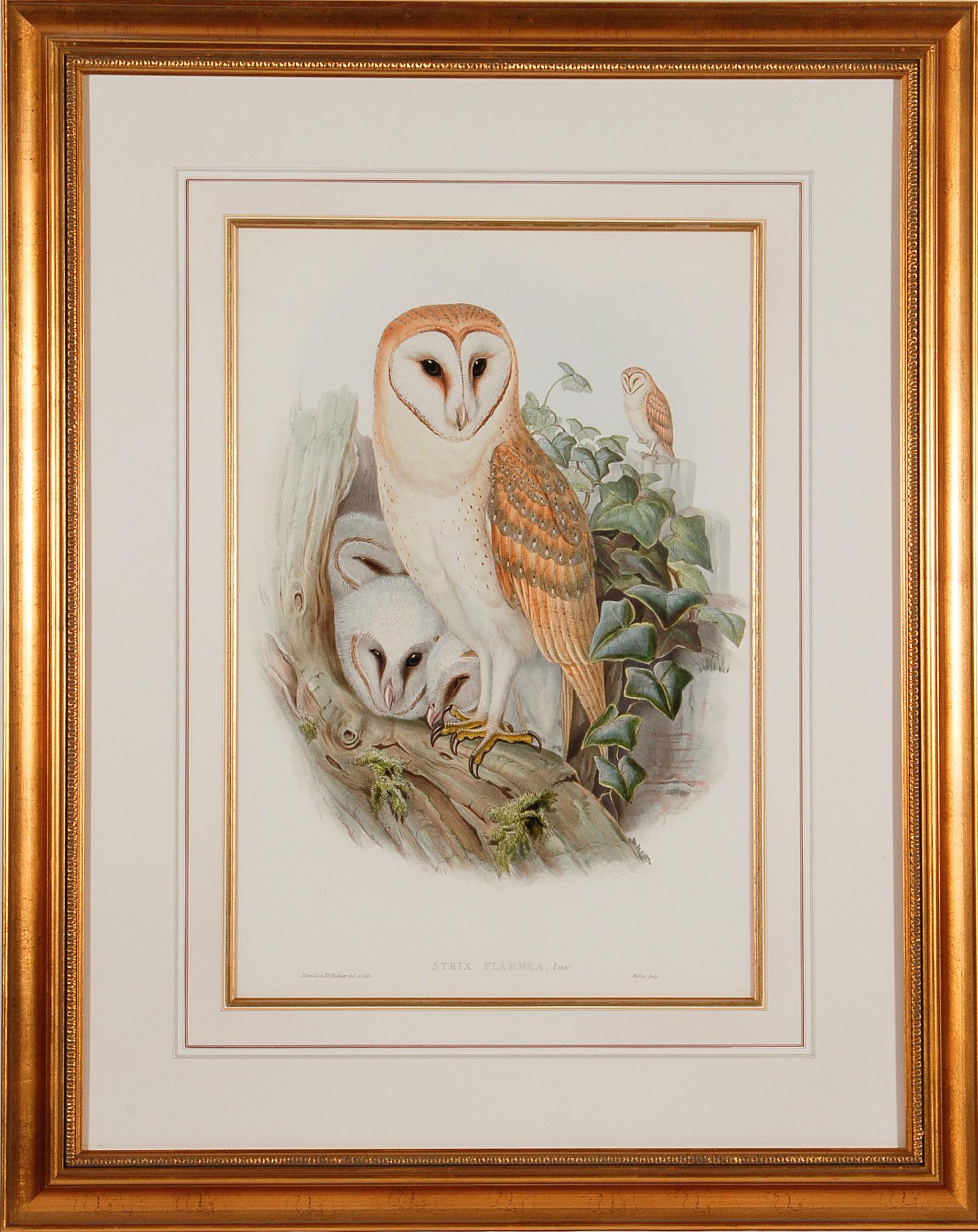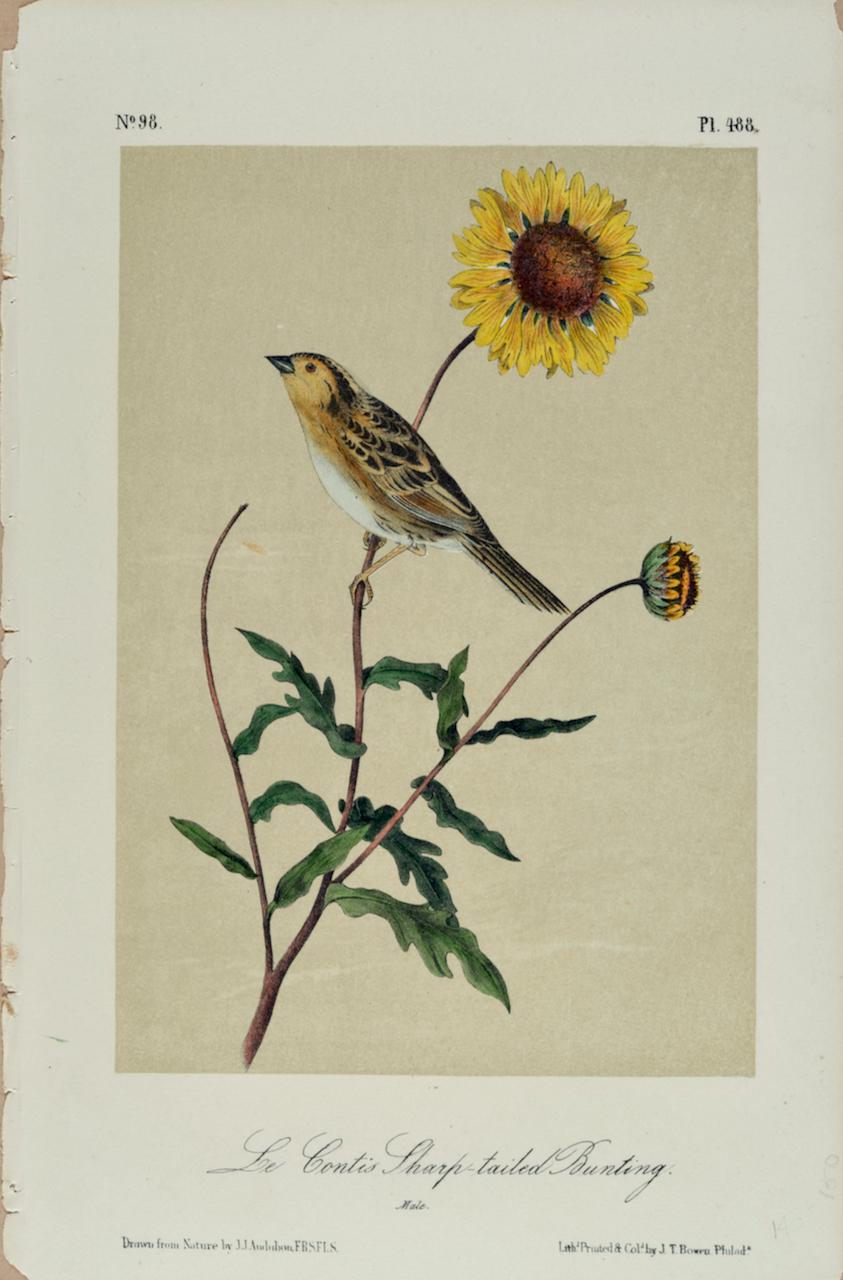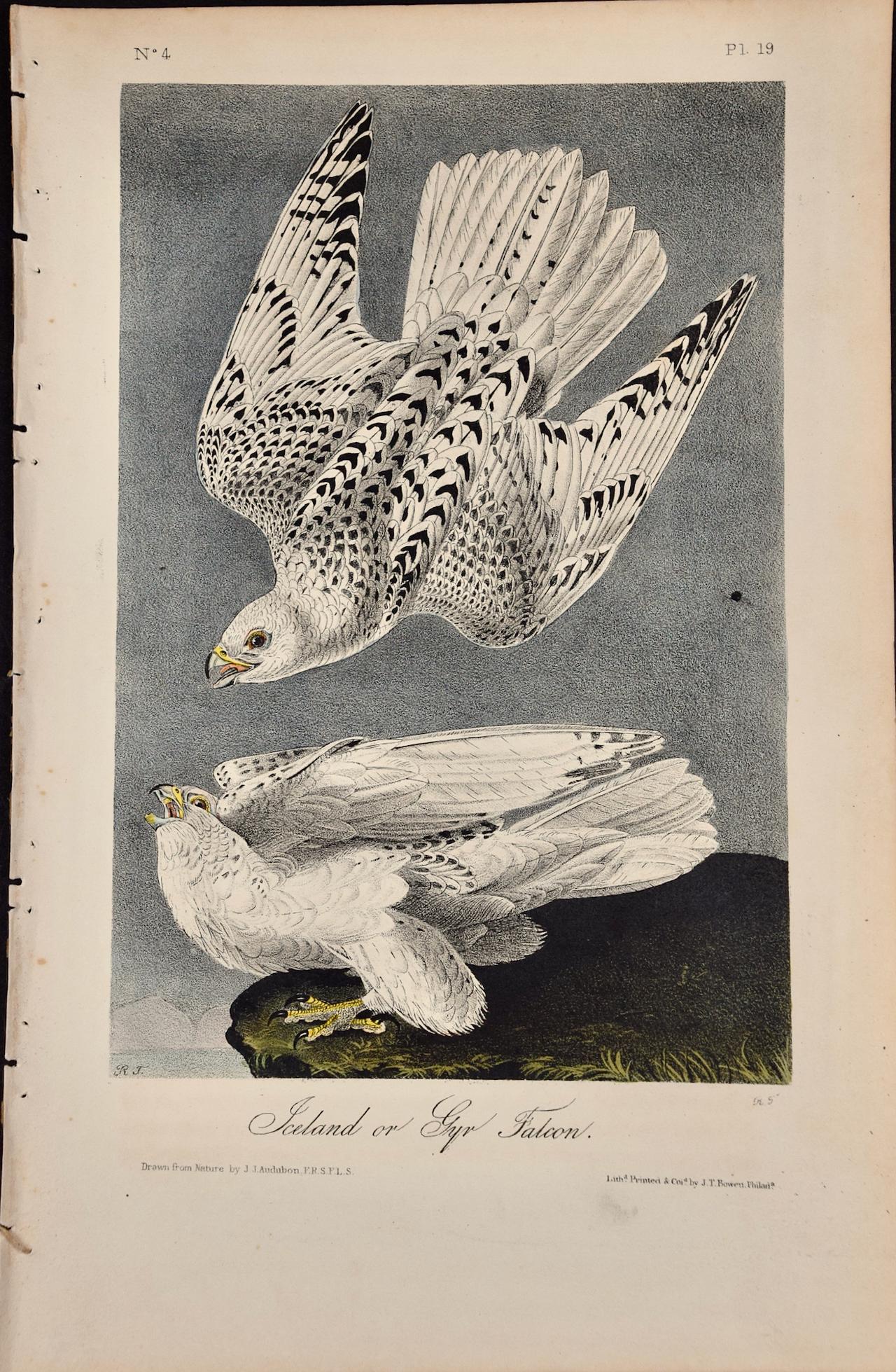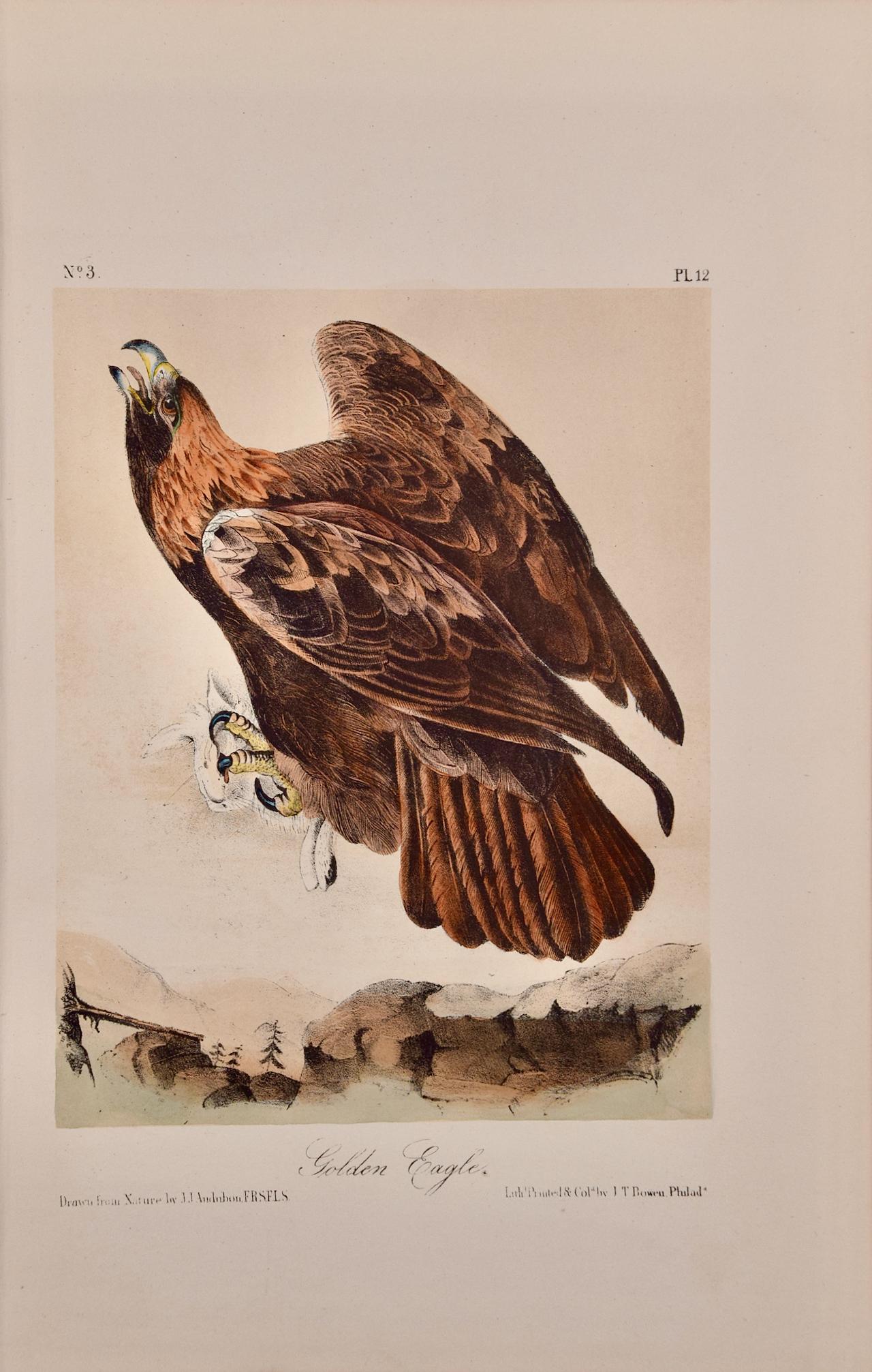Items Similar to Two Snowy Owls
Want more images or videos?
Request additional images or videos from the seller
1 of 5
Roger Tory PetersonTwo Snowy Owls
About the Item
Color Lithograph
Image Size: 30 x 19 inches
Framed Size: 40.25 x 29.75 inches
Edition 392/950
Artist Signed and Numbered
Artist and naturalist Roger Tory Peterson, initially famous for his 1934 field guide to the study of birds, was born of Swedish immigrant, working-class parents in 1908 in rural Jamestown, in upstate New York. As a boy, apparently imbued with a passion present from birth, he observed and sketched the abundant birds of wood and field. He also read about Audubon, Lear, Durer and Fuertes, artists who painted nature. His interest in birds was also guided by his seventh grade teacher, Blanche Hornbeck, who had started a Junior Audubon Club. Peterson has said, " I can't remember a time when I didn't watch birds"
Peterson later studied commercial art at the Art Students League and National Academy of Design in New York City. As a young man, after his schooling, he taught art and science in Massachusetts, where he created his unique system for identifying birds in the field. He later developed and published more than fifty other guides on subjects as diverse as mushrooms, clouds, fish, stars and insects.
One of the world's preeminent naturalists, Peterson's identification system for birds in their natural habitat was called the greatest invention since binoculars. He commented on the book, its methods and origins in 1980: "In 1934 there was nothing remotely like the Field Guide in print. Still, I can't take credit for inventing something out of whole cloth. My special contribution was the visual element within a carefully chosen context. Other ornithologists, both noted and nameless, had worked out the field marks of most birds. I combined their knowledge with my visual presentation and, at the urging of two friends in particular, carried the idea through. Their encouragement, my native interest in birds, and my professional training as an artist enabled me to create something that appeared new, though it was really a kind of fertile hybrid."
Peterson credits Ernest Thompson Seton's semi-autobiographical story, "Two Little Savages," with awakening him to the individuality in the markings of birds. Peterson says, "I don't remember when I first read that tale. As a boy I found my most faithful friends in books Somewhat solitary, I was fascinated by birds and that set me distinctly apart. In Jamestown, New York, and throughout the nation, bird watchers were rare. They were considered kooks, though we didn't have that word then (I was called a number of other things, names I'd rather leave unspoken)."
Peterson was twice nominated for a Nobel Prize, receiving every major award for ornithology, natural science, and conservation. He was awarded twenty-two honorary degrees, as well as numerous medals and citations, including the Presidential Medal of Freedom.
Peterson was also a worldwide filmmaker, making films in Europe, Africa, the Arctic, Galapagos Islands, Antarctica as well as at home in America. For more than thirty years, Peterson was art director for the National Wildlife Federation. He was a member of the board of directors of Defenders of Wildlife from 1965 to 1973. Peterson was also art editor of the National Audubon Society's magazine, as well as in charge of their educational programs.
Peterson's paintings are in the collections of the Metropolitan Museum of Art, New York City; Minneapolis Institute of Art; and the Leigh Yawkey Woodson Art Museum. They were exhibited at the Smithsonian Institution, Washington, D.C. and California Academy of Sciences.
Roger Tory Peterson died on July 28, 1996 at his home in Old Lyme, Connecticut. He was 87.
- Creator:Roger Tory Peterson (1908 - 1996, American)
- Dimensions:Height: 40.25 in (102.24 cm)Width: 29.75 in (75.57 cm)
- Medium:
- Movement & Style:
- Period:
- Condition:The lithograph is in excellent condition. The frame does have some scuff/scrapes to the left side. Please email or call if you would like to see more detailed images.
- Gallery Location:Missouri, MO
- Reference Number:1stDibs: LU74732249743
About the Seller
5.0
Vetted Seller
These experienced sellers undergo a comprehensive evaluation by our team of in-house experts.
Established in 1970
1stDibs seller since 2017
141 sales on 1stDibs
Typical response time: 23 hours
- ShippingRetrieving quote...Ships From: Missouri, MO
- Return PolicyA return for this item may be initiated within 2 days of delivery.
More From This SellerView All
- Nasiterna BruijniBy John GouldLocated in Missouri, MOJohn Gould (British, 1804-1881) Nasiterna Bruijni c. 1849-1861 Hand Colored Lithograph Image Size: approx 19.5 x 13.5 inches Framed Size: 27 3/8 x 21 1/2 inches John Gould was an English ornithologist and bird artist. The Gould League in Australia was named after him. His identification of the birds now nicknamed "Darwin's finches" played a role in the inception of Darwin's theory of evolution by natural selection. Gould's work is referenced in Charles Darwin's book, On the Origin of Species. Gould was born in Lyme Regis, Dorset, the son of a gardener, and the boy probably had a scanty education. Shortly afterwards his father obtained a position on an estate near Guildford, Surrey, and then in 1818 became foreman in the Royal Gardens of Windsor. He was for some time under the care of J T Aiton, of the Royal Gardens of Windsor. The young Gould started training as a gardener, being employed under his father at Windsor from 1818 to 1824, and he was subsequently a gardener at Ripley Castle in Yorkshire. He became an expert in the art of taxidermy, and in 1824 he set himself up in business in London as a taxidermist, and his skill led to him becoming the first Curator and Preserver at the museum of the Zoological Society of London in 1827. Gould's position brought him into contact with the country's leading naturalists, and also meant that he was often the first to see new collections of birds given to the Society. In 1830 a collection of birds arrived from the Himalayas, many not previously described. Gould published these birds in A Century of Birds from the Himalaya Mountains (1830-1832). The text was by Nicholas Aylward Vigors, and the illustrations were lithographed by Gould's wife Elizabeth, daughter of Nicholas Coxen of Kent. This work was followed by four more in the next seven years including Birds of Europe in five volumes - completed in 1837, with the text written by Gould himself, edited by his clerk Edwin Prince. Some of the illustrations were made by Edward Lear as part of his Illustrations of the Family of Psittacidae in 1832. Lear however was in financial difficulty, and he sold the entire set of lithographs to Gould. The books were published in a very large size, imperial folio, with magnificent coloured plates. Eventually 41 of these volumes were published with about 3000 plates. They appeared in parts at £3 3s. a number, subscribed for in advance, and in spite of the heavy expense of preparing the plates, Gould succeeded in making his ventures pay and in realizing a fortune. In 1838 he and his wife moved to Australia to work on the Birds of Australia and shortly after his return to England, his wife died in 1841. When Charles Darwin presented his mammal and bird specimens collected during the second voyage of HMS Beagle to the Geological Society of London at their meeting on 4 January 1837, the bird specimens were given to Gould for identification. He set aside his paying work and at the next meeting on 10 January reported that birds from the Galápagos Islands, which Darwin had thought were blackbirds, "gross-bills" and finches were in fact "a series of ground Finches which are so peculiar" as to form "an entirely new group, containing 12 species." This story made the newspapers. In March, Darwin met Gould again, learning that his Galápagos "wren" was another species of finch and the mockingbirds he had labeled by island were separate species rather than just varieties, with relatives on the South American mainland. Subsequently Gould advised that the smaller southern Rhea specimen that had been rescued from a Christmas dinner...Category
1850s Naturalistic Animal Prints
MaterialsLithograph
- Nasiterna PygmaeBy John GouldLocated in Missouri, MOJohn Gould (British, 1804-1881) Nasiterna Pygmae c. 1849-1861 Hand Colored Lithograph Image Size: approx 19.5 x 13.5 inches Framed Size: 27 3/8 x 21 1/2 inches John Gould was an English ornithologist and bird artist. The Gould League in Australia was named after him. His identification of the birds now nicknamed "Darwin's finches" played a role in the inception of Darwin's theory of evolution by natural selection. Gould's work is referenced in Charles Darwin's book, On the Origin of Species. Gould was born in Lyme Regis, Dorset, the son of a gardener, and the boy probably had a scanty education. Shortly afterwards his father obtained a position on an estate near Guildford, Surrey, and then in 1818 became foreman in the Royal Gardens of Windsor. He was for some time under the care of J T Aiton, of the Royal Gardens of Windsor. The young Gould started training as a gardener, being employed under his father at Windsor from 1818 to 1824, and he was subsequently a gardener at Ripley Castle in Yorkshire. He became an expert in the art of taxidermy, and in 1824 he set himself up in business in London as a taxidermist, and his skill led to him becoming the first Curator and Preserver at the museum of the Zoological Society of London in 1827. Gould's position brought him into contact with the country's leading naturalists, and also meant that he was often the first to see new collections of birds given to the Society. In 1830 a collection of birds arrived from the Himalayas, many not previously described. Gould published these birds in A Century of Birds from the Himalaya Mountains (1830-1832). The text was by Nicholas Aylward Vigors, and the illustrations were lithographed by Gould's wife Elizabeth, daughter of Nicholas Coxen of Kent. This work was followed by four more in the next seven years including Birds of Europe in five volumes - completed in 1837, with the text written by Gould himself, edited by his clerk Edwin Prince. Some of the illustrations were made by Edward Lear as part of his Illustrations of the Family of Psittacidae in 1832. Lear however was in financial difficulty, and he sold the entire set of lithographs to Gould. The books were published in a very large size, imperial folio, with magnificent coloured plates. Eventually 41 of these volumes were published with about 3000 plates. They appeared in parts at £3 3s. a number, subscribed for in advance, and in spite of the heavy expense of preparing the plates, Gould succeeded in making his ventures pay and in realizing a fortune. In 1838 he and his wife moved to Australia to work on the Birds of Australia and shortly after his return to England, his wife died in 1841. When Charles Darwin presented his mammal and bird specimens collected during the second voyage of HMS Beagle to the Geological Society of London at their meeting on 4 January 1837, the bird specimens were given to Gould for identification. He set aside his paying work and at the next meeting on 10 January reported that birds from the Galápagos Islands, which Darwin had thought were blackbirds, "gross-bills" and finches were in fact "a series of ground Finches which are so peculiar" as to form "an entirely new group, containing 12 species." This story made the newspapers. In March, Darwin met Gould again, learning that his Galápagos "wren" was another species of finch and the mockingbirds he had labeled by island were separate species rather than just varieties, with relatives on the South American mainland. Subsequently Gould advised that the smaller southern Rhea specimen that had been rescued from a Christmas dinner...Category
Mid-19th Century Naturalistic Animal Prints
MaterialsLithograph
- Herring GullsBy Jamie WyethLocated in Missouri, MOJamie Wyeth "Herring Gulls" 1978 Color Lithograph Signed Lower Right Numbered Lower Left 149/300 Born in 1946, James Browning Wyeth came of age when the meaning of patriotism was clouded by the traumas of the Vietnam War and the scandals of Watergate. Working in an era of turmoil and questioning of governmental authority, he did art that encompassed both marching off to war and marching in protest. One of James's early masterworks, Draft Age (1965) depicts a childhood friend as a defiant Vietnam-era teenager resplendent in dark sunglasses and black leather jacket in a suitably insouciant pose. Two years later Wyeth painstakingly composed a haunting, posthumous Portrait of President John F. Kennedy (1967) that seems to catch the martyred Chief Executive in a moment of agonized indecision. As Wyeth Center curator Lauren Raye Smith points out, Wyeth "did not deify the slain president, [but] on the contrary made him seem almost too human." Based on hours of study and sketching of JFK's brothers Robert and Edward - documented by insightful studies in the exhibition - the final, pensive portrait seemed too realistic to family members and friends. "His brother Robert," writes Smith in the exhibition catalogue, "reportedly felt uneasy about this depiction, and said it reminded him of the President during the Bay of Pigs invasion." In spite of these misgivings, James's JFK likeness has been reproduced frequently and is one of the highlights of this show. The poignancy, appeal and perceptiveness of this portrait, painted when the youngest Wyeth was 21 years old, makes one wish he would do more portraits of important public figures. James himself feels he is at his best painting people he knows well, as exemplified by his vibrant Portrait of Jean Kennedy Smith (1972), which captures the vitality of the slain President's handsome sister. He did paint a portrait of Jimmy Carter for the January 1977 man-of-the-year cover of Time magazine, showing the casually dressed President-elect as a straightforward character posed under a flag-draped water tower next to the family peanut plant in Plains, Ga. James recalls that Carter had one Secret Service agent guarding him as he posed outdoors, a far cry from the protection our Chief Executives require today. As a participating artist in the "Eyewitness to Space" program organized by the National Aeronautics and Space Administration in collaboration with the National Gallery of Art in the late 1960s, Wyeth deftly recorded in a series of watercolors his eyewitness observations of dramatic spacecraft launchings and more mundane scenes associated with the space program. Commissioned by Harper's Magazine to cover the 1974 congressional hearings and trials of Watergate figures, James Wyeth executed a series of perceptive and now evocative sketches that recall those dark chapters in our history. Memorable images include a scowling John Ehrlichman, a hollow-eyed Bob Haldeman, an owlish Charles Colson, a focused Congressman Peter Rodino, a grim visaged Father/ Congressman Robert Drinan, and vignettes of the press and various courtroom activities. An 11-by-14-inch pencil sketch of the unflappable Judge John Sirica is especially well done. These "images are powerful as historical records," observes Smith, "and as lyrically journalistic impressions of events that changed the nation forever." Wyeth's sketch of early-morning crowds lined up outside the Supreme Court building hoping to hear the Watergate case, with the ubiquitous TV cameramen looking on, is reminiscent of recent scenes as the high court grappled with the Bush-Gore contest. The Wyeth family penchant for whimsy and enigmatic images is evident in Islanders (1990), showing two of James's friends, wearing goofy hats, sitting on the porch of a small Monhegan Island (Me.) cottage draped with a large American flag. Mixing the serious symbolism of Old Glory with the irreverent appearance of the two men, James has created a puzzling but interesting composition. Painting White House...Category
1970s American Modern Animal Prints
MaterialsPaper, Lithograph
- One of Their Pets (Two Farm Boys and Cow at the Watering Hole)By Joseph VorstLocated in Missouri, MOOne of Their Pets (Two Farm Boys and Cow at The Watering Hole) By Joseph Vorst (1897-1947) Signed Lower Right Edition 1/50 Lower Left Unframed: 8.5" x 11" Framed: 16" x 18.5" German-born Joseph Vorst came from Essen (born June 19, 1897). His teacher was the leading German impressionist Max Liebermann (1847-1935), who was the champion of French impressionism in Berlin. He had traveled to Barbizon and Paris to see paintings by Manet first hand, including In the Conservatory, which made its way to Berlin. Later Vorst's home town of Essen would acquire a collection of modern art in 1921, which became the Museum Folkwang, one of the earliest of its kind. Most likely to escape the Nazis, Vorst made his way to Missouri; we know that he was a member of the American Artists Congress and he signed the famous "Call" in 1936 at the group's first congress, the left-wing organization that stood up to combat fascism. Surely he would have known Joe Jones...Category
Early 20th Century American Realist Landscape Prints
MaterialsLithograph
- Bird's Eye ViewBy Ronnie CutroneLocated in Missouri, MORonnie Cutrone (1948-2013) "Bird's Eye View" c. 1980s Color Lithograph Ed. 222/250 Signed, Numbered and Titled Image Size: 17 x 23.5 inches Framed Size: approx. 24 x 30 inches. Ronnie Cutrone, a figurehead of the Pop and Post-Pop art scenes, was Andy Warhol's assistant at the Factory atop the Decker Building from 1972-1980, and worked closely with Roy Lichtenstein, combining stylistic elements of both. Cutrone's large-scale paintings of American cartoon icons, like Mickey Mouse, Felix the Cat, and Woody Woodpecker further reinvented kitsch and popular media in terms of fine art. Executed in fluorescent monochromatic colors with the finesse of mass-produced silkscreen and prints, Cutrone's works are the reverse of tromp-l'oeil; they use fine art media (watercolor, pastel, crayon - on high-quality paper) to celebrate, rather than hide, the artifice of their subjects. "Everything is cartoon for me", Cutrone is noted for saying, even "ancient manuscripts...Category
Late 20th Century Pop Art Figurative Prints
MaterialsLithograph
- American Eagle (Nest Builder III)By Ted BlaylockLocated in Missouri, MOTed Blaylock (b. 1946) "Nest Builder III" 1986 Print Ed. 586/950 Signed and Numbered Ted Blaylock opened his own art studio and gallery in Collinsville, IL in 1969. He eventually mo...Category
1980s American Realist Animal Prints
MaterialsLithograph, Paper
You May Also Like
- Barn Owl Family: A Framed Original 19th C. Hand-colored Lithograph by GouldBy John Gould and Henry Constantine RichterLocated in Alamo, CAThis is a framed original 19th century hand-colored folio-sized lithograph entitled “Strix Flammea” (Barn Owl) by John Gould, from his "Birds of Great Britain", published in London between 1862 and 1873. The print depicts an adult Barn Owl perched on a log its three baby owls to the left. Another adult owl in the background on the right, presumably a male, watches over his family. There are leaves on the right contributing to this pleasant landscape composition. This striking framed Gould...Category
Mid-19th Century Naturalistic Animal Prints
MaterialsLithograph
- Le Contis Sharp-tailed Bunting: Original Audubon Hand-colored Bird LithographBy John James AudubonLocated in Alamo, CAThis is an original 19th century John James Audubon hand-colored lithograph entitled "Le Contis Sharp-tailed Bunting, Male", No. 98, Plate 488 from Audubon's "Birds of America, litho...Category
Mid-19th Century Naturalistic Animal Prints
MaterialsLithograph
- Iceland or Gyr Falcon: An Original 1st Ed. Audubon Hand-colored Bird LithographBy John James AudubonLocated in Alamo, CAThis is an original rare first edition John James Audubon hand-colored lithograph entitled "Iceland or Gyr Falcon", No. 4, Plate 19 from Audubon's "Birds of America, lithographed, pr...Category
Mid-19th Century Naturalistic Animal Prints
MaterialsLithograph
- American Coot: An Original 19th C. Audubon Hand-colored Bird LithographBy John James AudubonLocated in Alamo, CAThis is an original 19th century John James Audubon hand-colored lithograph entitled "4128 Audubon, Purple Gallinule, Adult Male, Spring Plumage", No. 61, Plate 303 from Audubon's "B...Category
Mid-19th Century Naturalistic Animal Prints
MaterialsLithograph
- Golden Eagle: An Original 19th C. Audubon Hand-colored Bird LithographBy John James AudubonLocated in Alamo, CAThis is an original John James Audubon hand-colored lithograph entitled "Golden Eagle", No. 3, Plate 12 from Audubon's "Birds of America, lithographed, printed and colored by JT Bowe...Category
Late 19th Century Naturalistic Animal Prints
MaterialsLithograph
- American Bittern: An Original 1st Ed. Audubon Hand-colored Bird LithographBy John James AudubonLocated in Alamo, CAThis is an original 19th century 1st octavo edition John James Audubon hand-colored lithograph entitled "American Bittern, 1. Male 2. Female", No. 73, Plate 365 from Audubon's "Birds of America, lithographed, printed and colored by J. T. Bowen and published in Philadelphia between 1840-1844. It depicts male and female American Bittern birds standing on the ground, each looking in opposite directions. There is high grass in the background. This original 1st octavo edition hand-colored Audubon American Bittern lithograph is in excellent condition, other than a few tiny spots, which appear most likely inclusions related to the paper manufacture. The sheet measures 6.5" high by 10.25" wide. The original text pages, 94-98, from Audubon's 19th century publication are included with the lithograph. John James Audubon (1785-1851) was a naturalist and artist. He was initially unsuccessful financially prior to the publication of his famous work “The Birds of America”, spending time in debtor’s prison, once stabbing a disgruntled investor in self-defense. However, his obsession with birds and art motivated him to persist in his goal of documenting every bird in America via his watercolor paintings and publishing his works for all to enjoy. Audubon's first illustrations were published in a large elephant folio...Category
Mid-19th Century Naturalistic Animal Prints
MaterialsLithograph





